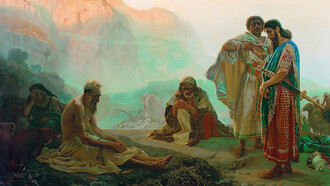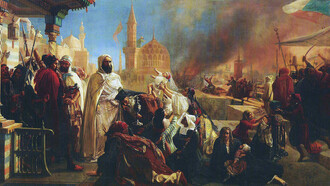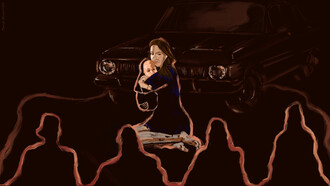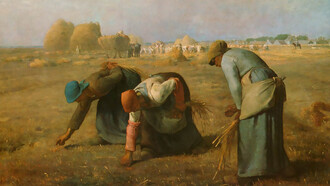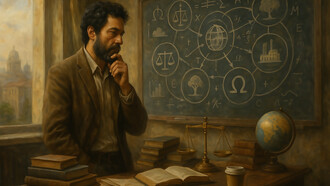Alex Revzan is a museum consultant and freelance historian who leverages his wide-ranging interest in history in his work with museums and historical societies. With a BA in History and an MA in Public History Mr. Revzan worked in a variety of museum roles over the years prior to founding Exhibition Outcomes, LLC in early 2022. The goal of Exhibition Outcomes is to help provide museums and other institutions with high-quality educational content so that they can fulfill their missions. In an environment of limited budgets (and often limited staff), consultants like Mr. Revzan play a vital role as force multipliers by helping institutions create more and better educational content while reducing the burden on museum resources. And, in this capacity, Exhibition Outcomes has been busy developing training materials, exhibition tours, as well as walking tours focused on a variety of historical topics.
You were the graduate student from Northern Illinois University who discovered historical footage of Eastland Disaster of 1915? What can you tell us about this tragedy and how you came across this important discovery?
Well, first of all, the basics of the disaster are pretty simple. On 24 July 1915 the Western Electric Co. chartered several ships to take their employees from Chicago to Michigan City Ind. for their annual company picnic. The Eastland was tied up in the Chicago River between LaSalle St. and Clark St. This was the first ship to start loading passengers. Approximately 2500 people loaded onto the Eastland (not counting crew) and before the ship could even untie from the dock it began to list. It listed first away from the dock and then back toward it. Eventually, it took a list to port that the crew could not correct and the ship rolled in the river. By the end of the day 844 people had lost their lives. To this day it is the deadliest maritime disaster in U.S. history.
My connection with the Eastland and the film began in Feb. of 2015, which happened to be the centenary year of the disaster. Early that month a PhD. student at the University of Illinois at Chicago had, in the course of his research on an unrelated topic, come across some films of the Eastland that had been lost over the years. He and Ted Wachholtz, the Executive Director of the Eastland Disaster Historical Society were featured on Chicago Tonight, a current affairs program on the Chicago PBS affiliate. Among other things they discussed was the possibility of there being more film out there that was still lost. So, long story short, the next day I checked out a film archive that I knew of and started looking for films of shipwrecks from that period that might not have been recognized as the Eastland when they were cataloged. And, after a bit over an hour of looking I actually found one that looked promising. So, I ran the clip I had found side by side with the one that had just been discovered and was able to match up several points of similarity. It looked good so I send the clip I found off to the Eastland Disaster Historical Society to see what they thought. About fifteen minutes later I received an email back saying that, yes, I had indeed found more previously lost footage of the Eastland. And so, on the foot of this, I had my fifteen minutes of fame.
The art of pistol dueling was a deep-rooted practice in American culture and flourished in the nineteenth century. Was it also practiced in Chicago?
That’s an interesting question. Thus far I have not found any accounts of pistol duels taking place in Chicago. This is not to say that it absolutely never, ever happened. As a historian one has to be very careful saying never, ever. That being said, if any pistol duels did occur in Chicago they would have been very rare and probably limited to the earliest days of the city’s history in the late 1830s or very early 1840s. The reason I say this is twofold; firstly, many of the earliest settlers were from upstate New York and New England. These were places that were far less hospitable to the duel of honour than the southern states. Secondly, Chicago was founded during the years when whatever dueling did take place in the northern states was in terminal decline. That being said, I have come across a few accounts of duels being fought in Chicago in the later part of the 19th century. These were, however, contested with swords rather than pistols. And even then, at least one of these accounts is an absolute fabrication. But it does need to be pointed out that even though formal dueling never gained any traction in Chicago, the city was from its earliest days a very violent place as frontier settlements tend to be.
The saloon was a place that, at its most basic, served drink. In one of your essays you mention that a saloon was an institution that existed roughly between the end of the Civil War and the start of Prohibition in 1920. What is the saloon history in Chicago?
Certainly. I guess my first point would be that the periodization of the Saloon Era is, like most periodization in history, i.e. something of a construct where many, if not most historians agree that certain years define an era. So, were there saloons around prior to the American Civil War? Absolutely there were, but the years between 1870 and 1920 saw a huge expansion of them, especially in urban areas. And this is actually an interesting point. I think there is, especially in popular culture a tendency to associate the saloon with cowboys and the Old West. However, the saloon, as an institution, was far more an urban thing- and within that, it was an institution of primarily northern cities. In large measure saloons expanded for economic reasons, caused by the increasing industrial scale of both brewing and distilling in the United States. So, as the number of saloons increase they start to become more important in the lives of city dwellers and then they begin to attract the attention of the reformers who were not very pleased with this trend.
As for the saloons in Chicago, they would have been very similar to those found in New York, Pittsburgh, or really any other northern, industrial city. In these places, they functioned as centers of neighborhood life, especially for working-class and immigrant communities. The saloon was a place where you could meet with people from the same country as yourself, or in the same trade as yourself. In many ways, the saloonkeeper functioned as in important node for information and services. For example, if you needed a job he might know who is hiring. If you need your paycheck cashed and you didn’t have a bank the saloonkeeper would often do that for you. And, as the saloon was quite often connected to local politicians (especially those of the various “machines” across the country), they were important hubs for connecting people with patronage jobs and social services in an era before civil service reform and a more formal social safety net.
According to Chicago encyclopedia, the city of Chicago emerged as the fourth largest Irish city by 1860? Although Chicago became racially and ethically diverse, why did the Irish continue to be well represented at the highest levels in politics and religion?
Well, this is quite a question. In reality, this could be the subject of an entire monograph. However, as space is limited, I shall briefly touch on one point. One reason that I think that the Irish were able to do so well in places like politics and the Church is that they had to. When large numbers of Catholic Irish started to arrive in the United States in the years of, and immediately after the Irish Famine (An Gorta Mór) faced the brunt of nativist hostility in the United States. While large numbers of people from the German lands were also immigrating during this period they did not face the same kind of vitriol as did the Irish, largely because many German immigrants were protestant, unlike the majority Catholic Irish. And so, Irish people had to stick together and establish some solidarity if they were going to survive and prosper in their new land. And in doing so, the Irish in America drew on long experiences from Ireland. For a long time, the Irish had worked to maintain their Catholic faith despite the hostility of the established church. There was also a long tradition of political organization in opposition to British rule. And so, when they arrived on these shores, they continued on in the same vein. And so, this is at least part of the reason we find the Irish such a prominent force in political organizations in places like Chicago, New York, and Boston.
It is highly unlikely that we will ever have definitive knowledge of the real cause of the Chicago fire of 1861 Does Mrs O'Leary's cow legend have any truth to it? What is your opinion?
Firstly, no, the story that has come down through the years of how the Great Chicago Fire started is patently not true. In the immediate aftermath of the fire, the city conducted an investigation into the origins of the disaster and it is clear that Catherine O’Leary was not milking her cow at gone nine at night. She, her husband Patrick, and their children were all tucked up in bed when the alarm was raised. And, indeed the investigation absolved her of any blame. The story that she was in the barn milking her cow when the cow kicked over a lantern was concocted by the, one must say, shockingly nativist press of the day. This tale had (and continues to have) traction because for the middle and upper classes in Chicago of the time (read largely Anglo and overwhelmingly protestant) Mrs. O’Leary represented the “dangerous classes”. She was Irish, an immigrant, and Catholic. All of this combined to make her almost the perfect scapegoat for a disaster that destroyed around one-third of the city.
That being said, yes the fire did indeed start in her barn. But, how that happened? I’m afraid we will never know for sure. There have been, over the years, many different theories put forward. Some of them are more plausible than others. For example, some people have speculated that the fire was caused by a meteor- mainly because a much larger fire occurred in Peshtigo, WI the same night. Some people even thought the fire was started by French communards who had escaped Paris after the destruction of the Paris Commune. Neither of these are very plausible. Most likely the fire was an accident caused by one of the O’Leary’s neighbours. It is possible someone had snuck into the barn to steal some milk, it is possible that someone snuck in to have a smoke and the unfortunate thing happened. However, this is one of those things we won’t ever really know for sure.
The future of museums will be characterized by cultural diversity. The ability to understand the multicultural makeup of museum visitors will equip institutions with the knowledge required for creativity and innovation. Managing culturally diverse employees is a key challenge, especially in the museum and tourism industry, where people with diverse cultural backgrounds from all over the world interact with each other. Do you provide a platform for museum curators of —international, national, local, emerging, and established—to present special solo projects or to participate in unique collaborations or thematic exhibitions?
This a very interesting question and I think I’ll try and answer this in two parts. First, yes- diversity is definitely an important issue in museums today. And given this, the ability to create content for a variety of audiences is vital for museums to be able to fulfill their missions. What’s more, museums need to be mindful to not only address diverse external audiences but diverse internal stakeholders as well. We all come to the table with different experiences and knowledge and it is important that things like educational content, exhibition didactics, as well as staff training, take this into account.
As for the second part, I assume you are asking about the Substack that I publish. As of now, I don’t have any plans to open that up to other contributors. I started that as a way to provide an archive of writing samples for prospective clients and more generally as a way to grow the Exhibition Outcomes brand. That might change in the fullness of time, we’ll see how that goes.
Since the inception of Exhibitions Outcomes, Mr. Revzan has been helping museums with the challenges they face in creating outstanding educational content especially as they emerge from the pandemic. His ultimate goal is to create visitor experiences that are powerful, entertaining, thought-provoking, and memorable.








